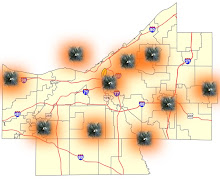Carolyn Strauss, director of SlowLAB, a design think tank based in New York and Amsterdam, presented her work and thoughts to a small audience at the Idea Center on April 22. Her lecture was the second in the current Talalay Lecture Series “The New Face of Architecture” sponsored by the Cleveland Museum of Contemporary Art (MOCA).
Unfortunately for the audience, there was nothing really new about her ideas, thoughts, or work, or anything readily applicable to architectural generation. Rather the talk was purely anecdotal and catalogue-like, warm-and-fuzzy, and unsubstantial.
The crux of Strauss’s presentation centered on the idea of “the slow” or the concept of “slowness,” a so-called movement that searches to leach out the hidden textures, histories, and dynamics of a given space, artifact, infrastructure, setting, atmosphere, or event. The slowness notion, according to Strauss, can be traced back to the slow food movement, which sought the raise awareness of local cuisine and food production in specific regions of Italy. Supposedly this notion of the slow is transferrable to other creative disciplines, such as architecture and urban design. Strauss sought to make these connections between ideas of regional cuisine with ideas of recent installation art and urban mapping from around the world, often citing the work a confederation of designers, artists, cartographers, and geographers.
Yet very little of the work was architectural in the traditional sense. The work shown varied from the documentation of weeds and flowers embedded in walls or sidewalk cracks, installation projection art that simulated a tree shedding leaves, and a documentary focusing on the plight of an immigrant shoe repair shop and its owner. While singularly interesting and potentially potent, the exhibited work as a collection did not cohesively suggest a new paradigm of thought that could manifest in a slow architecture or slow urbanism.
Ultimately many in the audience recognized that the lecture was merely an index of catalogued resistant moments in our globalized economy and culture. This resistance is not really new, novel, or groundbreaking in thought or practice—similar resistance practices and thought can be found in many disciplines being executed around the world. The idea of resistance or critical resistance, again, is nothing new.
The notion of a slow resistance or merely slowness in architecture and urbanism is hardly novel. Firstly we can look to Marxist architectural historian Kenneth Frampton and his ever-evolving essay “Critical Regionalism” which exhibits the notion of global-resistive regionalism in architectural design. Slowness can be found in the delicate essays of David Leatherbarrow, a theorist who writes cogently about weathering, surfacing, and siting of architecture within specific environments. The slow can also be weaned from the writings of landscape historians such a JB Jackson (The Necessity of Ruins) and John Stilgoe (Outside Lies Magic). Although the above are authors and not designers, they do posit notions and provide potential constitutional foundations for slow design.
But that is not to say that slowness has not been made manifest through existing built work. Exhibitions of slowness can be found in the contemporary phenomenological architecture of Tod Williams + Bille Tsien, Juhani Pallasmaa, Steven Holl, Will Bruder, Rick Joy, Jacque Herzog + Pierre De Meuron, among many others. Much of the work of the great Alvar Aalto possesses a prediction towards the phenomenological and ruination, and therefore the slow. Whether or not identified taxonomically within the current milieu , slowness already does possess a pedigree within the cannon of 20th century modernism.
In conclusion we were disappointed in the lack of a rigorous process and annunciation of principal that such a doctrine can possess. The notion of slowness does possess merit and potential, even if its recent incarnation and presentation was rather shallow and directionless. Strauss should continue her work but recognize the movement’s hagiography and situate the antecedents that should strengthen the work.
As for MOCA’s selection of lecturers in this series, the museum is batting well below its average. Strauss’s talk was clearly weak. Although the Ball + Nogues lecture received only luke-warm praise, the duo’s built work and installations at least provided hope for a furtherance of thought. Let’s hope that Cameron Sinclair’s talk later this week provides an actual new face of architecture, not merely a simulacrum.
Subscribe to:
Post Comments (Atom)





No comments:
Post a Comment